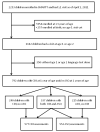Evaluation of risk for late language emergence after in utero antiretroviral drug exposure in HIV-exposed uninfected infants
- PMID: 24067563
- PMCID: PMC3785009
- DOI: 10.1097/INF.0b013e31829b80ee
Evaluation of risk for late language emergence after in utero antiretroviral drug exposure in HIV-exposed uninfected infants
Abstract
Background: Combination antiretroviral (cARV) regimens are recommended for pregnant women with HIV to prevent perinatal HIV transmission. Safety is a concern for infants who were HIV-exposed but uninfected, particularly for neurodevelopmental problems, such as language delays.
Methods: We studied late language emergence (LLE) in HIV-exposed but uninfected children enrolled in a US-based prospective cohort study. LLE was defined as a caregiver-reported score ≤10th percentile in any of 4 domains of the MacArthur-Bates Communicative Development Inventory for 1-year olds and as ≥1 standard deviation below age-specific norms for the Ages and Stages Questionnaire for 2-year olds. Logistic regression models were used to evaluate associations of in utero cARV exposure with LLE, adjusting for infant, maternal and environmental characteristics.
Results: 1129 language assessments were conducted among 792 1- and 2-year-old children (50% male, 62% black and 37% Hispanic). Overall, 86% had in utero exposure to cARV and 83% to protease inhibitors. LLE was identified in 26% of 1-year olds and 23% of 2-year olds, with higher rates among boys. In adjusted models, LLE was not associated with maternal cARV or ARV drug classes in either age group. Among cARV-exposed 1-year olds, increased odds of LLE was observed for those exposed to atazanavir (adjusted odds ratio = 1.83, 95% confidence interval: 1.10-3.04), particularly after the first trimester (adjusted odds ratio = 3.56, P = 0.001), compared with atazanavir-unexposed infants. No associations of individual ARV drugs with LLE were observed among 2-year olds.
Conclusions: In utero cARV exposure showed little association with LLE, except for a higher risk of language delay observed in 1-year-old infants with atazanavir exposure.
Figures
References
-
- Reilly S, Bavin EL, Bretherton L, et al. The Early Language in Victoria Study (ELVS): A prospective, longitudinal study of communication skills and expressive vocabulary development at 8, 12 and 24 months. International Journal of Speech-Language Pathology. 2009;11(5):344–357.
-
- Feldman HM, Dollaghan CA, Campbell TF, Kurs-Lasky M, Janosky JE, Paradise JL. Measurement properties of the MacArthur Communicative Development Inventories at ages one and two years. Child Dev. 2000;71(2):310–322. - PubMed
-
- Quigley MA, Poulsen G, Boyle E, et al. Archives of Disease in Children: Fetal & Neonatal Edition. 2011. Early term and late preterm birth are associated with poorer school performance at age 5 years: a cohort study. - PubMed
Publication types
MeSH terms
Substances
Grants and funding
LinkOut - more resources
Full Text Sources
Other Literature Sources
Medical


